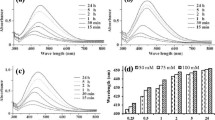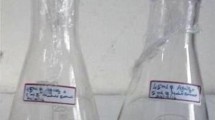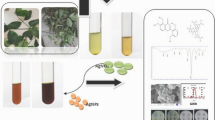Abstract
The objectives of the present study were to examine the influence of visible light photons on photoreduction of the silver nanoparticles (AgNPs), detect optoelectronic feedback, and observe the antimicrobial activity. For this purpose, an optoelectronic device was designed and successfully tested. The finding shows that identical nanocomplexes with silver salt express various responses to the LEDs with different wavelengths by scattering different portions of light. It is the first time to discuss the effect of visible light photons on nano-sized particles in detail based on the quantitative optical/voltage analysis. The photoreduction of the AgNPs is in good agreement with photon energy and the AgNPs occur in nanocomplex in a wavelength versus time-dependent manner. The blue LED having photon energy 7.04 eV reduces the average size of AgNPs down to the range 4–6 nm in 12 min, while AgNPs obtained under influence of green (6.11 eV) and red (5.04 eV) LEDs have average sizes 6–8 nm and 12–14 nm respectively. The successful synthesis of AgNPs was additionally examined using UV–Vis, SEM, XPS, XRD, FTIR, and TEM techniques. AgNPs proved for antimicrobial activity against Escherichia coli 25922, Enterococcus faecalis 29212, Pseudomonas aeruginosa 27853, and Candida albicans 10231 at four different concentrations. The antibacterial test for all selected bacteria showed that AgNPs which have an average size of 4-6 nm synthesized by blue LED revealed the largest inhibition zone around 16–11 mm, while the antifungal test shows that the maximum inhibition zone was exposed by AgNPs which have an average size of 6–8 nm synthesized by red LED.







Similar content being viewed by others
References
Ahmad MZ, Akhter S, Jain GK, Rahman M, Pathan SA, Ahmad FJ, Khar RK (2010) Metallic nanoparticles: technology overview & drug delivery applications in oncology. Expert Opin Drug Deliv 7(8):927–42
Bunyatova U, Hammouda MB, Zhang J (2021) Novel light-driven functional AgNPs induce cancer death at extra low concentrations. Sci Rep 11:13258
Rai M, Ingle AP, Birla S, Yadav A, dos Santos CA (2016) Strategic role of selected noble metal nanoparticles in medicine. Crit Revi Microbiol 42(5):696–719
Rzayev Z, Bunyatova U, Lowell J, Shen W, Thomay T, Carwright A (2018) Novel Ag-carried CMC/functional copolymer/ODA-Mt wLED-treated NC and their responses to brain cancer cells. Mater Sci Eng, C 8(11):463–476
Yang Y, Matsubara S, Xiong L (2007) Solvothermal synthesis of multiple shapes of silver nanoparticles and their SERS properties. J Phys Chem 111:9095–9104
Salkar RA, Jeevanandam P, Aruna ST, Koltypin Y, Gedanken A (1999) The sonochemical preparation of amorphous silvernanoparticles. J Mater Chem 9:13
Lee PC, Merisel D (1982) Adsorption and surface-enhanced Raman of dyes on silver and gold sols. J Phys Chem 86:3391–3395
Simakin AV, Voronov VV, Kirichenko NA, Shafeev GA (2004) Nanoparticles produced by laser ablation of solids in liquidenvironment. Appl Phys A 79:1127
Naik RR, Stringer SJ, Agarwal G, Jones SE, Stone O (2002) Biomimetic synthesis and patterning of silver nanoparticles. Nat Mater 1:169–172
Singh J, Dutta T, Kim KH et al (2018) ‘Green’ synthesis of metals and their oxide nanoparticles: applications for environmental remediation. J Nanobiotechnol 16:84. https://doi.org/10.1186/s12951-018-0408-4
Iqtedar M, Aslam M, Akhyar M, Shehzaad A, Abdullah R, Kaleem A (2019) Extracellular biosynthesis, characterization, optimization of silver nanoparticles (AgNPs) using Bacillus mojavensis BTCB15 and its antimicrobial activity against multidrug resistant pathogens. Prep Biochem Biotechnol 49(2):136–142. https://doi.org/10.1080/10826068.2018.1550654
Zia R, Riaz M, Faroo N, Qamar A, Anjum S (2018) Antibacterial activity of Ag and Cu nanoparticles synthesized by chemical reduction method: a comparative analysis. Mater Res Express 5:7
Rzayev Z, Erdonmez D, Erkan K, Simsek M, Bunyatova U (2015) Functional copolymer/organo-MMT Nanoarchitectures. XXII. Fabrication and characterization of antifungal and antibacterial poly (vinyl alcohol-co-vinyl acetate/ODA-MMT/AgNPs nanofibers and nanocoatings by e-spinning and c-spinning methods. Int J Polym Mater 64:267–278
Marambio-Jones C, Hoek EMV (2010) A review of the antibacterial effects of silver nanomaterials and potential implications for human health and the environment. J Nanopart Res 12:1531–1551
Chouhan N (2018) Silver nanoparticles: synthesis, characterization and applications, book. In Silver Nanoparticles: Fabrication, Characterization and Applications. IntechOpen. https://doi.org/10.5772/intechopen.75611
Xu L, Wang YY, Huang J, Chen CY, Wang ZX, Xie H (2020).Silver nanoparticles: synthesis, medical applications and biosafety. Theranostics 10(20):8996–9031. https://doi.org/10.7150/thno.45413
Altinsoy BD, Karatoprak GS, Ocsoy I (2019) Extracellular directed ag NPs formation and investigation of their antimicrobial and cytotoxic properties c. Saudi Pharm J 27:9–16
Akhtar M, Panwar J, Yun YS (2013) Biogenic synthesis of metallic nanoparticles by plant extracts. ACS Sustain Chem Eng 1:591–602
Emam HE, El-Bisi MK (2014) Merely Ag nanoparticles using different cellulose fibers as removable reductant. Cellulose 21(6):4219–4230
Trader DJ, Carlson EE (2012) Chemoselective hydroxyl group transformation: an elusive target. Mol Biosyst 8(10):2484–2493
Shaikh WA, Chakraborty S, Owens G, Islam RU (2021) A review of the phytochemical mediated synthesis of AgNP (silver nanoparticle): the wonder particle of the past decade. Appl Nanosci 11(11):2625–2660. https://doi.org/10.1007/s13204-021-02135-5
Wang WS, Du H, Wang RX, Wen T, Xu AW (2013) Heterostructured Ag3PO4/AgBr/Ag plasmonic photocatalyst with enhanced photocatalytic activity and stability under visible light. Nanoscale 5(8):3315–3321. https://doi.org/10.1039/c3nr00191a
Tighe-Neira R, Carmora E, Recio G, Nunes-Nesi A, Reyes-Diaz M, Alberdi M, Rengel Z, Inostroza-Blancheteau C (2018) Metallic nanoparticles influence the structure and function of the photosynthetic apparatus in plants. Plant Physiol Biochem 130:408–417
Han P, Martens W, Waclawik E, Sarina S, Zhu HY (2018) Metal nanoparticle photocatalysts: Synthesis, characterization, and application. Part Part Syst Charact 35(6):17004891–16
Wiley BJ et al (2006) Maneuvering the surface plasmon resonance of silver nanoparticles through shape- controlled synthesis. J Phys Chem B 110(32):15666–15675
Noginov MA et al (2007) Te efect of gain and absorption on surface plasmons in metal nanoparticles. Appl Phys B 86:455–460
Maretti L, Billone PS, Liu Y, Scaiano JC (2009) Facile photochemical synthesis and characterization of highly fluorescent silver nanoparticles. J Am Chem Soc 131(39):13972–13980. https://doi.org/10.1021/ja900201k
Oliveira E, Santos HM, Garcia-Pardo J, Diniz M, Lorenzo J, Rodríguez-González B, Capelo JL, Lodeiro C (2013) Synthesis of functionalized fluorescent silver nanoparticles and their toxicological effect in aquatic environments (Goldfish) and HEPG2 cells. Front Chem 5(1):29. https://doi.org/10.3389/fchem.2013.00029
Meng Y (2015) A Sustainable Approach to Fabricating Ag Nanoparticles/PVA Hybrid nanofiber and its catalytic activity. Nanomaterials (Basel) 5(2):1124–1135. https://doi.org/10.3390/nano5021124
Anju K, AnithaJegadeeshwari L, Nagendra Gandhi N (2018) optimization of green synthesized silver nanoparticles from caralluma umbellata. Int J Appl Pharm 10(4):103
Ashraf H, Anjum T, Riaz S, Naseem S (2020) Microwave-assisted green synthesis and characterization of silver nanoparticles using melia azedarach for the management of fusarium wilt in tomato. Front Microbiol 10(11):238. https://doi.org/10.3389/fmicb.2020.00238.PMID:32210928;PMCID:PMC7076090
Bandla M, Abbavaram BR, Kokkarachedu V, Sadiku RE (2017) Silver nanoparticles incorporated within intercalated clay/polymer nanocomposite hydrogels for antibacterial studies. Polym Compos 38:E16–E23. https://doi.org/10.1002/pc.23963
Shameli K, Bin Ahmad M, Zargar M, Yunus WM, Ibrahim NA, Shabanzadeh P, Moghaddam MG (2011) Synthesis and characterization of silver/montmorillonite/chitosan bionanocomposites by chemical reduction method and their antibacterial activity. Int J Nanomedicine 6:271–84
Aziz SB at al (2019) Structural, thermal, morphological and optical properties of PEO filled with biosynthesized Ag nanoparticles: New insights to band gap study. Results Phys 13. https://doi.org/10.1016/j.rinp.2019.102220
Brza MA (2020) at al The study of EDLC device with high electrochemical performance fabricated from proton ion conducting pva-based polymer composite electrolytes plasticized with glycerol. Polymers (Basel) 12(9):1896
Hamsan MH, Shukur MF, Aziz SB, Kadir MFZ (2019) Dextran from Leuconostoc mesenteroides-doped ammonium salt-based green polymer electrolyte. Bull Mater Sci 42:57
A Mohammadi, Barikani M, Barmar M (2015) Synthesis and investigation of thermaland mechanical properties of in situ prepared biocompatible Fe3O4/polyurethane elastomer nanocomposites. Polym Bull 72(2):219–234. https://doi.org/10.1007/s00289-014-1268-1
Kumar H at al (2013) Structural characterization of silver nanoparticles synthesized by micro emulsion route. Int J Eng Innov Technol (IJEIT) 3(3):2277–3754. ISO 9001:2008
Yasmeen S, Kanti Kabiraz M, Saha B, Rakibul Qadir M, Abdul Gafur M, Md Masum S (2015) Chromium (VI) ions removal from tannery effluent using chitosan-microcrystalline cellulose composite as adsorbent. Int Res J Pure Appl Chem 10(4):1–14. https://doi.org/10.9734/IRJPAC/2016/23315
http://users.wfu.edu/wrightmw/chm122/handouts/IRFunGroup.pdf]
Applications of Infrared spectroscopy in biochemistry, Biology, and Medicine pp 165–172. Springer New York, NY. https://doi.org/10.1007/978-1-4684-1872-9
Chrzanowska E, Gierszewska M, Kujawa J, Raszkowska-Kaczor A, Kujawski W (2018) Development and characterization of polyamide-supported chitosan nanocomposite membranes for hydrophilic pervaporation. Polymers (Basel) 10(8):868
Bagleyt GK at al (1982) Fourier transform infrared difference. spectroscopy of bacteriorhodopsin and its photoproducts. Biophysics 79(16):4972–4976. https://doi.org/10.1073/pnas.79.16.4972
Zeng QH, Wang DZ, Yu AB, Lu GQ (2002) Synthesis of polymer-montmorillonite nanocomposites by in situ intercalative polymerization. Nanotechnology 13(5):549–553
Hayati-Ashtiani M (012) Use of FTIR spectroscopy in the characterization of natural and treated nanostructured bentonites montmorillonites. Part Sci Tech 30(6):553–564. https://doi.org/10.1080/02726351.2011.615895
Synthesis, technology and applications of carbon nanomaterials (2019). Elsevier. https://doi.org/10.1016/C2017-0-03040-9
Rayleigh L (1871) On the scattering of light by small particles. Philos Mag 41:447–454
Wang ZB, Luk’yanchuk BS, Hong MH, Lin Y, Chong TC (2004) Energy flow around a small particle investigated by classical Mie theory. Phys Rev B 7003541. https://doi.org/10.1103/PhysRevB.70.035418
van de Hulst HC (1981) light scattering by small particles. Dover, New York 15. https://doi.org/10.1002/actp.1984.010350426
Hainga M et al (2016) Absorption and scattering cross-section extinction values of silver nanoparticles. Opt Mater 58:439–444
Song JE, Park JH, La JA, Park S, Jeong MK, Cho EC (2016) Use of fluorescence signals generated by elastic scattering under monochromatic incident light for determining the scattering efficiencies of various plasmonic nanoparticles. Analyst 15. https://doi.org/10.1039/C6AN00399K
Helmlinger J, Sengstock C, Groß-Heitfeld C, Mayer C, Schildhauer TA, Koller M, Epple M (2016) Silver nanoparticles with different size and shape: equal cytotoxicity, but different antibacterial effects. RSC Adv 6(22):18490–18501. https://doi.org/10.1039/C5RA27836H
Marghany M in synthetic aperture radar imaging mechanism for oil spills, quantize of scattering theory
Itagaki H (2000). Experimental methods in polymer science. Modern Methods in Polymer Research and Technology. A volume in Polymers, Interfaces and Biomaterials Book pp 155–260. https://doi.org/10.1016/B978-0-08-050612-8.50009-X
Swanson NL, Billard BD, Gennaro TL (1999) Limits of optical transmission measurements with application to particle sizing techniques. Appl Opt 38:5887–5893
Myers JA, Curtis BS, Curtis WR (2013) Improving accuracy of cell and chromophore concentration measurements using optical density. BMC Biophysics 6:4
Paramelle D, Sadovoy A, Gorelik S, Free P, Hobley J, Fernigb DG (2014) Rapid method to estimate the concentration of citrate capped silver nanoparticles from UV-visible light spectra. The Analyst 19. https://doi.org/10.1039/c4an00978a
Free P, Paramelle D, Bosman M, Hobley J, Fernig DG (2012) Synthesis of silver nanoparticles with monovalently functionalized self-assembled monolayers. Chem 65:275–282
Li G, Liu L, Sun Y, Liu H (2018) Ecofriendly synthesis of silver–carboxy methyl cellulose nanocomposites and their antibacterial activity. J Clust Sci 29:1193–1199. https://doi.org/10.1007/s10876-018-1426-y
Basuny M, Ali IO, Abd EA, Bakr MF, Salama TM (2015) A fast green synthesis of Ag nanoparticles in carboxymethyl cellulose (CMC) through UV irradiation technique for antibacterial applications. J Sol-Gel Sci Technol 75:530–540. https://doi.org/10.1007/s10971-015-3723-3
Agnihotri S, Mukherji S, Mukherji S (2014) Size-controlled silver nanoparticles synthesized over the range 5–100 nm using the same protocol and their antibacterial efficacy. RSC Adv 4:3974
Sondi I, Salopek-Sondi B (2004) Silver nanoparticles as antimicrobial agent: a case study on E. coli as a model for Gram-negative bacteria. J Colloid Interface Sci 275(1):177–182
Liao S, Zhang Y, Pan X, Zhu F, Jiang C, Liu Q, Cheng Z, Dai G, Wu G, Wang L, Chen L (2019) Antibacterial activity and mechanism of silver nanoparticles against multidrug-resistant Pseudomonas aeruginosa. Int J Nanomed 1469–1487. https://doi.org/10.2147/IJN.S191340
Rajasekhar R, James B, Devadathan A, Soman S, Sebastian VM, Sathyan M (2022) An in vitro evaluation of antibacterial and smear layer removal efficacy of silver nanoparticles as final irrigant against enterococcus faecalis. World J Dent 13(2). https://doi.org/10.5005/jp-journals-10015-1913
Author information
Authors and Affiliations
Corresponding author
Ethics declarations
Conflict of interest
The authors declare no competing interests.
Additional information
Publisher's note
Springer Nature remains neutral with regard to jurisdictional claims in published maps and institutional affiliations.
Topical Collection on Nanoarchitectonics for Functional Particles and Materials.
Rights and permissions
Springer Nature or its licensor (e.g. a society or other partner) holds exclusive rights to this article under a publishing agreement with the author(s) or other rightsholder(s); author self-archiving of the accepted manuscript version of this article is solely governed by the terms of such publishing agreement and applicable law.
About this article
Cite this article
Bunyatova, U., Kocum, I.C., Turkmen, K.E. et al. Novel concept on in situ syntheses and investigation of photon energy effect on AgNP size with a custom build device for enhanced antimicrobial efficiency. J Nanopart Res 24, 249 (2022). https://doi.org/10.1007/s11051-022-05612-2
Received:
Accepted:
Published:
DOI: https://doi.org/10.1007/s11051-022-05612-2
Keywords
- Silver nanoparticles
- Bionanocomposites
- LED-driven AgNPs
- Visible light-sensitive optoelectronic circuit
- Antimicrobial activity




